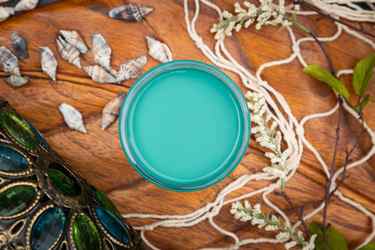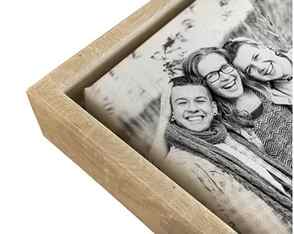Here we have our birch cluster, just add the bird house.
How to Simply Paint Birch Trees with Watercolors

Aren’t birch trees glorious? Their bark is just phenomenal . . . so much that I honestly couldn’t tell you what birch leaves even look like right now. Which doesn’t matter to paint birch trees in Winter – the trunks alone are enough. And that’s why I chose them for my January calendar. If you missed it, go grab some free wallpaper for your phone or desktop computer. Or better yet, paint your own!
And yes, my friends, we’re using watercolors. WATERCOLORS. Correct me if I’m wrong but I believe this is my first tutorial using watercolors. But make no mistake, I am a total beginner with so much to learn. So please forgive any blatant errors as I’m learning the way I learned to paint murals – fake it til I make it.
I realize I’ve been using watercolors nearly exclusively for the past while – because I absolutely love them! – but I did a faux birch craft a while back with craft acrylics you might like.
I also realize that any painting tutorial is easier to understand with video and I’m working on it. I know. I know. I’ve said that a gazillion times before but I really am now! To paint these birch trees though you really don’t need a video, it’s that simple.
Paint Birch Trees with Watercolors
There are a lot of differences between acrylics and watercolors, especially when it comes to the color white. With watercolor, it’s easier to mask those parts out, like the birch tree trunks. Painter’s tape is perfect for this.

Step 1 – tape vertical lines for your trunks, tearing the tape with rough edges on one side for randomness.

Step 2 – Apply a grey-brown wash a little south of center on your paper to represent background trees.
To paint this wash, add water to black, same to burnt umber, and maybe a little white as well. You want enough water to make the color very light. Keep in mind that watercolors dry lighter than when they are wet though.
After the colors are mixed and wet, moisten the paper with your brush where you want your background trees, then load your round brush with the grey-brown color and paint the section. The upper edge will have curves and the bottom will be uneven with no distinct shapes.
Confused yet? Don’t be. It’s much easier than I make it out to be, ok?

Using your brush as a loose guide, let the paint blend with the wet paper. Almost like painting the top of clouds, if you will.

Notice the difference in the shades even though I didn’t paint more than one layer. It depends on how wet your brush is, how much color is on your brush and how wet the paper is.
You don’t control watercolors. At least I don’t. I have such fun watching the paint after I’ve applied it. Paint, watch. Paint, watch. It’s meditative and relaxing, really.
Huh. Who knew doing something you can’t control is relaxing? I should’ve painted with watercolors when my kids teenagers.

Look at the bottom of the background on the right. It looks like drips, doesn’t it? Actually it might be but I left them that way or painted them to represent tree trunks.

Step 3 – With the same color mixture of grey/brown define a few background trees by loosely adding branches.
Keep in mind they’re background so no big deal. If you want some help freehanding branches, check out How to Paint a Spooky Tree.

Step 4 – remove the painter’s tape.

Step 5 – Loosely outline the trunks with the same light grey/brown as the background.
It doesn’t matter if your outlines are thin or thick, even or random. As a matter of fact, you could skip this step altogether because you’ll add more outline layers in darker colors. I happen to like lots of layers because it adds depth to paintings.

Step 6 – Darken your paint with more black and brown, less water, and outline the trunks.
You still want a very watery combination of paint though. Notice in the photo above how one trunk is more on the grey side and the other has more brown tones. You could forgo the brown altogether but I like how it softens the tan/grey/black a bit.

Step 7 – Paint the darker color on the trunks from the outside in.
Use my painting as a guide or google ‘birch trees’ to get a better idea what they really look like. Just don’t get too intent on getting your painting to match the photo. Oh, how I used to spend hours and hours doing that and the time I invested was never even noticed.
Paint, watch. Paint, watch. Move on.

I was nearly finished when I checked a photograph and saw the little dots were more to the side than the middle. Oh well. There will be many more birch tree paintings.
As a matter of fact, I think I’ll do a video class (or two) on them. One for acrylics and one for watercolors.

Last step – with watery black/brown, paint tiny branches here and there.
Again, use the photo as a guide, if you wish. But I bet at this point your painting is already beautiful and the branches are just the cherry on top. Seriously! This is a great beginner or intermediate or advanced painting.
You might wanna make one branch long enough for a bird or two to perch upon.
Let me know how you like this tutorial and if you’d like more watercolor paintings. As I mentioned, I’ll be doing video classes primarily in acrylics but I’ll throw in easy watercolors here and there too.
Comments
- Marianne says January 4, 2016 at 8:34 am
They look great Colleen. Thanks for adding watercolour to your list.
- Colleen says January 4, 2016 at 10:30 am
Hey Marianne! Well, I’m not an expert watercolorist – far from it. But I can share as I learn . . . even mistakes. Watercolors are so fun even the mistakes wind up kinda pretty. xo
Colleen
Beautiful and a great tutorial, too! Thanks, Colleen!
Happy New Year!
Ooh Colleen, Love your water colored birch trees! Thank you for the tutorial. I had to Pin this one. You make it look so easy
- Colleen says January 7, 2016 at 8:38 am
Happy New Year, Laura! Yes, I’ll be doing more watercolor tutorials as I learn . . . along with mistakes, ha ha. xo
Colleen
Step #1
Using the photograph provided (or, where not available, the photo of the completed painting) lightly sketch in the design on your watercolour paper. When painting your own compositions, you should always spend some time on thumbnail sketches, planning the arrangement of your shapes. Remember to vary the size and contours while creating a design that you can paint without too much difficulty. You want to have some fun during the painting. the journey is just as important as the destination.

Thoroughly soak the paper by immersing it in a tub of water for about 5-10 minutes allowing the paper to stretch. This will open up the fibers of the paper letting the pigment settle, while reflecting the white of the paper towards the eye and thus creating the luminous look of stained glass. The final piece should look like a watercolour painting, not just a painting done with watercolour pigment.
Really soak up that surface water!!
Step #3
Holding your paper carefully by the corners, let excess water drip off and then place onto your board. Now, roll your towel over the paper several times. The paper should remain damp but not wet – all glisten or shine should disappear. You now have a workable surface which will allow you to easily achieve both hard and soft edges at will.
Tape the edges to your board. The water trapped under the paper will allow a greater “window” of working time.
Important Note: When I speak of a rich puddle in the following pages, I mean a mixture of paint through which you cannot see the bottom of the palette. The paint should appear to be the same intensity and value in the mixing area as it is in the well, but should contain enough water so that when scooped up with the brush and applied to the paper it goes on smoothly and does not give a dry brush effect. This will probably take a little practise in the beginning.
Birch Tree Watercolour Demo

Above is a photo of my completed painting. Because this is just a simple demo, I have not used a photo reference. To begin your painting – lightly draw the three large shapes. You will use these as a guide only and should not feel bound by the lines. Don’t let it bother you if your strokes happen to go outside these lines.
a faithful attempt
“A Faithful Attempt” is designed to showcase a variety of K-12 art lessons, the work of my art students, as well as other art-related topics. Projects shown are my take on other art teacher’s lessons, lessons found in books or else designed by myself. Thanks for visiting!
LAND ACKNOWLEDGEMENT I acknowledge, with deep respect, that I am gathered on Treaty 7 territory. I acknowledge the many First Nations, Métis and Inuit whose footsteps have marked these lands for generations. I recognize the land as an act of reconciliation and gratitude to those whose territory we reside on or are visiting.
Saturday, January 22, 2011

Ah, the ever-popular Birch Trees project! Art teachers, staff, students and parents LOVE this lesson. It always has a high success rate so all students, regardless of their art abilities, can succeed. I love projects like these.
Who doesn’t love the stark, bare beauty of birch trees set against the quietness of snow.
There’s lots of steps and lots of different versions out there on other art teacher blogs. I don’t know who the originator of this lesson is, but if you’re out there, thank you!
Here’s how Grade 7 students made their landscapes:
Show students photos or a slideshow of birch trees. Examine and discuss the bark. Discuss and explain the shadows, lighting and colours.
Start by drawing a wavy snow line towards the bottom of heavy white paper
(watercolour paper would be awesome but use what you have.)
Then, using masking tape, tape down some trees making sure to press the edges down firmly so the paint won’t seep under. If you want less straight trees, you can cut/rip the edges of the tape with scissors- it’s sticky and tricky but do-able.
TIP: To reduce the tape’s stickiness, so it peels off the paper later without ripping, I have the kids stick the tape first onto their clothing; something with alot of lint (soft shirt or sweater- even jeans will work). This technique takes aways the excess stickiness and helps it peel off easier later.
 |
| I provide three sizes of tape to help create the illusion of depth. |

Thinner tape goes in the background and thicker tape in the foreground- this gives a real illusion of depth and space. Remind students about background, middle ground, and foreground. Important step: for any tape that is in the snow, kids need to outline these lightly with a pencil- otherwise when the tape comes off, that part disappears.

Test out some nice shadow colors (pale blues, pale greys, etc.) in the sketchbook. and then paint them going straight in one direction: to the right or to the left, onto the snow- these are ‘cast shadows’. We just use our regular tempera discs and add lots of water.

Paint the sky with watercolours (we used tempera discs with lots of water added)- sunsets, sunrises, night sky- whatever you want. Blend colours using wet-on-wet technique. Back and forth using a wide, flat brush. This is where kids can get really creative with colour mixing.
I have them practice in their sketchbooks first.
 |
| testing sky colours in sketchbook first |

Now let it dry.
 |
| Painted sky and painted cast shadows. |


When painting the sky, you can also sprinkle some salt (regular or coarse salt) onto the wet paint which will create some interesting textural patterns once dry.
Once everything is dry (next class), carefully and slowwwwllllyyy, peel off the tape and you have a clean birch tree. Don’t worry about any bits of paint that have seeped under the tape- the black marking later will help disguise them.
Paint a light grey shadow on one side of the tree- the same side your cast shadow is going.
Below you can see I made mine on the right hand side. It is quite faint.

Using a thin brush, paint kind of curved grey/black markings on the tree.
Some students prefer to use a marker for this step.

For the final step, make falling snow by dipping the end of a
brush in white tempera and dabbing it all over the sky.
Grade 7 results:Ta da!























Posted by Miss at Saturday, January 22, 2011
Labels: Grade 7, landscape, watercolours, winter
14 comments:
Kathy said.
Thank you for the very complete tutorial on how you did this beautiful project of the birch trees in the snow. I sure like how the kids represented so many color schemes. We’ve done this lesson before and we didn’t have so many colorful options. I am more inspired to try it again after seeing the success you’ve had. Thanks!
Kristyn DeMint said.
They turned out beautifully!
Miss said.
Thanks Kathy & Kristyn~ it’s a fun project and the kids are usually pretty happy with how they turn out.
Jessica Young said.
These are so beautiful, and I love your detailed instructions! What grade did you do this project with?
Miss said.
Hi Jessica,
Thanks! These were made by Grade 7 students. It’s one of my favouite projects!
Laurie said.
I absolutely LOVE this. Awesome results! I usually don’t follow another one’s project step by step, but this time I will!
Miss said.
Laurie said.
The kids really liked to play with the colors. Do you mind if I share it on my blog (with a reference to yours)?
Miss said.
Laurie: of course, no problem!
Laurie said.
The kids LOVED to mix colors in the background. A lot of beautiful results. Thank you for this good idea!
Tracy said.
I have the kids look at a painting of Monet’s Poplars as inspiration for their birch tree paintings. At the end, we use a cardboard stamping technique to make the black lines on the trees. This is a favorite project, they always turn out so beautiful!
cheryl meehan said.
Thanks for providing the detailed instructions. Beautiful works. I like the zebra one.
Luluuu said.
These really do turn out beautifully. The first batch I made was on heavy paper. The second time, I decided to use a small canvas so we could present these as gifts, but the tape didn’t seem to stick very well onto the canvas and the paint seeped underneath. Any suggestions on what I could do to prevent this?
Miss said.
Luluuu: what type of tape did you use? I’ve seen tutorials on canvas where they used masking tape and acrylic paints (as opposed to watercolours). Acrylics shouldn’t seep underneath the tape. Maybe just try a different brand of tape that has more adhesion perhaps? Hope it works out!




